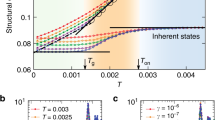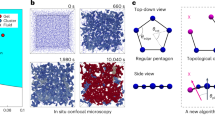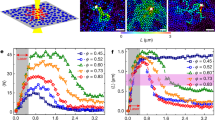Abstract
Glass is inherently unstable to crystallization. However, how this transformation occurs while the dynamics in the glass stay frozen at the particle scale is poorly understood. Here, through single-particle-resolved imaging experiments, we show that due to frozen-in density inhomogeneities, a soft colloidal glass crystallizes via two distinct pathways. In the poorly packed regions of the glass, crystallinity grew smoothly due to local particle shuffles, whereas in the well-packed regions, we observed abrupt jumps in crystallinity that were triggered by avalanches—cooperative rearrangements involving many tens of particles. Importantly, we show that softness—a structural-order parameter determined through machine-learning methods—not only predicts where crystallization initiates in a glass but is also sensitive to the crystallization pathway. Such a causal connection between the structure and stability of a glass has so far remained elusive. Devising strategies to manipulate softness may thus prove invaluable in realizing long-lived glassy states.
This is a preview of subscription content, access via your institution
Access options
Access Nature and 54 other Nature Portfolio journals
Get Nature+, our best-value online-access subscription
$29.99 / 30 days
cancel any time
Subscribe to this journal
Receive 12 print issues and online access
$209.00 per year
only $17.42 per issue
Buy this article
- Purchase on Springer Link
- Instant access to full article PDF
Prices may be subject to local taxes which are calculated during checkout



Similar content being viewed by others
Data availability
Source data are available for this paper from the corresponding authors upon reasonable request.
References
Kelton, K. F. & Greer, A. L. Nucleation in Condensed Matter: Applications in Materials and Biology Vol. 15 (Elsevier, 2010).
Mazur, P. Freezing of living cells: mechanisms and implications. Am. J. Physiol. 247, C125–C142 (1984).
Angell, C. A. Liquid fragility and the glass transition in water and aqueous solutions. Chem. Rev. 102, 2627–2650 (2002).
van Megen, W. & Underwood, S. M. Change in crystallization mechanism at the glass transition of colloidal spheres. Nature 362, 616–618 (1993).
Ingebrigtsen, T. S., Dyre, J. C., Schrøder, T. B. & Royall, C. P. Crystallization instability in glass-forming mixtures. Phys. Rev. X 9, 031016 (2019).
Craig, D. Q. M., Royall, P. G., Kett, V. L. & Hopton, M. L. The relevance of the amorphous state to pharmaceutical dosage forms: glassy drugs and freeze dried systems. Int. J. Pharm. 179, 179–207 (1999).
Greer, A. L. Metallic glasses. Science 267, 1947–1953 (1995).
Klein, W. & Leyvraz, F. Crystalline nucleation in deeply quenched liquids. Phys. Rev. Lett. 57, 2845–2848 (1986).
Yang, J., Gould, H. & Klein, W. Molecular-dynamics investigation of deeply quenched liquids. Phys. Rev. Lett. 60, 2665–2668 (1988).
Trudu, F., Donadio, D. & Parrinello, M. Freezing of a Lennard-Jones fluid: from nucleation to spinodal regime. Phys. Rev. Lett. 97, 105701 (2006).
Kawasaki, T. & Tanaka, H. Formation of a crystal nucleus from liquid. Proc. Natl Acad. Sci. USA 107, 14036–14041 (2010).
Tan, P., Xu, N. & Xu, L. Visualizing kinetic pathways of homogeneous nucleation in colloidal crystallization. Nat. Phys. 10, 73–79 (2014).
Gasser, U., Weeks, E. R., Schofield, A., Pusey, P. N. & Weitz, D. A. Real-space imaging of nucleation and growth in colloidal crystallization. Science 292, 258–262 (2001).
Sanz, E. et al. Crystallization mechanism of hard sphere glasses. Phys. Rev. Lett. 106, 215701 (2011).
Sanz, E. et al. Avalanches mediate crystallization in a hard-sphere glass. Proc. Natl Acad. Sci. USA 111, 75–80 (2014).
Montero de Hijes, P., Rosales-Pelaez, P., Valeriani, C., Pusey, P. N. & Sanz, E. Brownian versus Newtonian devitrification of hard-sphere glasses. Phys. Rev. E 96, 020602(R) (2017).
Yanagishima, T., Russo, J. & Tanaka, H. Common mechanism of thermodynamic and mechanical origin for ageing and crystallization of glasses. Nat. Commun. 8, 15954 (2017).
Rosales-Pelaez, P., Montero de Hijes, P., Sanz, E. & Valeriani, C. Avalanche mediated devitrification in a glass of pseudo hard-spheres. J. Stat. Mech. Theory Exp. 9, 094005 (2016).
Widmer-Cooper, A., Perry, H., Harrowell, P. & Reichman, D. R. Irreversible reorganization in a supercooled liquid originates from localized soft modes. Nat. Phys. 4, 711–715 (2008).
Golde, S., Palberg, T. & Schöpe, H. J. Correlation between dynamical and structural heterogeneities in colloidal hard-sphere suspensions. Nat. Phys. 12, 712–717 (2016).
Appignanesi, G. A., Rodríguez Fris, J. A., Montani, R. A. & Kob, W. Democratic particle motion for metabasin transitions in simple glass formers. Phys. Rev. Lett. 96, 057801 (2006).
Zhang, Z. et al. Thermal vestige of the zero-temperature jamming transition. Nature 459, 230–233 (2009).
Philippe, A. M. et al. Glass transition of soft colloids. Phys. Rev. E 97, 040601(R) (2018).
Hallett, J. E., Turci, F. & Royall, C. P. Local structure in deeply supercooled liquids exhibits growing length scales and dynamical correlations. Nat. Commun. 9, 3272 (2018).
Valeriani, C. et al. From compact to fractal crystalline clusters in concentrated systems of monodisperse hard spheres. Soft Matter 8, 4960–4970 (2012).
Schoenholz, S. S., Cubuk, E. D., Sussman, D. M., Kaxiras, E. & Liu, A. J. A structural approach to relaxation in glassy liquids. Nat. Phys. 12, 469–471 (2016).
Ma, X. et al. Heterogeneous activation, local structure, and softness in supercooled colloidal liquids. Phys. Rev. Lett. 122, 028001 (2019).
Crocker, J. C. & Grier, D. G. Methods of digital video microscopy for colloidal studies. J. Colloid Interface Sci. 179, 298–310 (1996).
Chang, C.-C. & Lin, C.-J. LIBSVM: a library for support vector machines. ACM Trans. Intel. Syst. Technol. 2, 27 (2011).
Lechner, W. & Dellago, C. Accurate determination of crystal structures based on averaged local bond order parameters. J. Chem. Phys. 129, 114707 (2008).
Acknowledgements
We thank H. K. Nagamanasa for synthesizing particles and the Supercomputing Education and Research Centre, Indian Institute of Science, for computational support by providing access to the high-performance Tyrone cluster. A.K.S. and D.G. thank the Department of Science and Technology (DST), Government of India, for financial support under a Year of Science Fellowship. R.G. thanks DST-Nanomission (SR/NM/TP-25/2016) for financial support.
Author information
Authors and Affiliations
Contributions
D.G., A.K.S. and R.G. planned the research. R.G. steered the research. D.G. performed the experiments, devised the analysis protocols and carried out the data analysis. D.C. performed the preliminary experiments. D.G. and R.G. wrote the paper; A.K.S. provided input.
Corresponding authors
Ethics declarations
Competing interests
The authors declare no competing interests.
Additional information
Publisher’s note Springer Nature remains neutral with regard to jurisdictional claims in published maps and institutional affiliations.
Extended data
Extended Data Fig. 1 Pair correlation function, g(r), for ϕ = 0.74.
Black solid line and red dashed line correspond to g(r) calculated over the first 4000s and the last 4000s of tini, respectively. tini is the time over which the sample remained amorphous and the MSD (shown in Fig. 1b) for the ϕ = 0.74 sample was calculated only over this time interval.
Extended Data Fig. 2 Three dimensional bond-orientational order, Q6, for ϕ = 0.74 at intermediate times.
a and b represent particles color-coded based on their 3-D bond orientational order corresponding to solid particle fraction, X = 0.08 and 0.1, respectively. Particles in purple are crystalline (Q6 > 0.25) and green ones are amorphous (Q6≤0.25).
Extended Data Fig. 3 Crystal growth trajectories for ϕ = 0.74.
a-d represent time evolution of solid particle fraction, X(t) of different crystallites in the field of view that exhibits step-like events. a and b show large changes δX(t) ≈ 0.2 which are rarer events as compared to c and d which exhibits multiple steps with δX(t) ≈ 0.1. e & f show two representative trajectories where the evolution in X(t) is relatively smoother. The trajectories correspond to different crystallites in the field of view for the same sample. In a-f the line connecting the endpoints of X(t) is shown in black and in a-d the grey-shaded regions represent plateaus in X(t) following a sudden jump.
Extended Data Fig. 4 Profiles of local slope of X(t) corresponding to different pathways for ϕ = 0.74.
Black lines in a and b represent time evolution of solid particle fraction, X(t), corresponding to avalanche-mediated and smooth growth, respectively. Blue lines denote instantaneous local slopes, m, evaluated over 20,000 s for the corresponding X(t) profiles. Large changes in X(t) during avalanche events in a is seen as sharp peaks in the corresponding m profile.
Extended Data Fig. 5 Visualization of MRCO and crystalline patches for the ϕ = 0.74 sample.
Yellow patches represent MRCO particle clusters obtained over the first sixth of the total experimental duration. Rendered coordinates in white represent crystalline particles at the end of the experiment. The shades of yellow represent the number of times MRCO particle clusters appeared in the region, n, lighter shade corresponding to lower times (see color bar).
Extended Data Fig. 6 Correlation between hard, soft, MRCO and crystalline particles for a 2D-slice for ϕ = 0.74.
The entire field-of-view of a sample 2-D slice is divided into 10σ × 10σ boxes. Normalized density ρi is plotted as a function of the box index i for various particle types. Orange, green, and gray colors correspond to MRCO, soft and hard particles, respectively. They are computed over an initial time interval corresponding to sixth of the experimental duration. ρi for crystalline particles (purple color) are calculated at the end of the experiment. Dashed lines drawn at \({\hat{\rho }}_{{\rm{i}}}\) = 1 represents the average value. Dashed vertical blue line corresponds to highly crystalline boxes and aids its comparison with other particle types.
Extended Data Fig. 7 Particle dynamics at ϕ = 0.74.
The bottom panels of a and b represent typical particle trajectories rescaled by the diameter σ and the top panels show their corresponding phop profiles. The highlighted regions correspond to sample hop-events with phop/σ2 exceeding 0.02 identified in our experiments. The time interval between successive peaks of the same particle is defined as tR and is marked in the top panels.
Extended Data Fig. 8 Choosing threshold value of phop and characterization of hopping events for ϕ = 0.74.
a, Black squares represent histogram of phop (rescaled by σ2) and red dashed line is a power-law fit to the tail of the distribution. The black dotted line corresponds to the threshold value, phop = 0.02 that best separates hop-events that account for rearrangements from noise due to fluctuations within a cage. b, is a semi-log plot of relation between average residence time and phop threshold values. tm is the value of residence time at the dashed line that is at phop = 0.02. pth chosen in our experiments lies in a region where changes in \(\left\langle {{\rm{t}}}_{{\rm{R}}}\right\rangle\) are very small. c and d, Distribution of hopping distances and durations P (Δr) and P (Δt) calculated over all the rearrangements with pth = 0.02.
Supplementary information
Supplementary Information
Supplementary Figs. 1–8 and Sections A–C.
Supplementary Video 1
Preprocessed images of devitrification of an ROI for ϕ = 0.74, drift corrected using Image registration in ImageJ. The ROI is in a 2D slice of a 3D sample and observed at a distance of 25 μm from the amorphous boundary to avoid wall effects. The crystal developed over a duration of 68 h. The video is sped up ~10,000 times.
Supplementary Video 2
Dynamics of devitrification of an ROI for ϕ = 0.74, exhibiting avalanche-like crystal growth. The ROI is in a 2D slice of a 3D sample and imaged at a distance of 25 μm from the amorphous boundary to avoid wall effects. Every frame in the video is generated by averaging particle positions over 6,000 s. Particle displacements (Δx/σ) follow the colour bar as in Fig. 2. At intermittent times, we observe collective motions of a large subset of particles in the ROI, which is identified as avalanche events in our experiments.
Supplementary Video 3
Dynamics of devitrification of an ROI for ϕ = 0.74, exhibiting smooth crystal growth. The ROI is in a 2D slice of a 3D sample and imaged at a distance of 25 μm from the amorphous boundary to avoid wall effects. Every frame in the video is generated by averaging particle positions over 6,000 s. Particle displacements (Δx/σ) follow the colour bar as in Fig. 2. At each instant in time, we find 10–15 particles undergoing string-like particle motion in the field of view, leading to a slow but steady growth of crystalline particles.
Supplementary Video 4
Dynamics of the entire field of view for ϕ = 0.74 of a 2D slice of our 3D system at a distance of 25 μm from the amorphous boundary. Different regions of the sample exhibit predominantly either intermittent avalanche events involving collective motion of 50–200 particles or string-like particle displacements with 10–20 particles. Both promote crystallization in our glassy system and occur depending on the local density of particles.
Rights and permissions
About this article
Cite this article
Ganapathi, D., Chakrabarti, D., Sood, A.K. et al. Structure determines where crystallization occurs in a soft colloidal glass. Nat. Phys. 17, 114–120 (2021). https://doi.org/10.1038/s41567-020-1016-4
Received:
Accepted:
Published:
Issue Date:
DOI: https://doi.org/10.1038/s41567-020-1016-4
This article is cited by
-
Fast crystal growth at ultra-low temperatures
Nature Materials (2021)
-
Morphological characterisation of 2D packing with bi-disperse particles
International Journal of Advances in Engineering Sciences and Applied Mathematics (2021)



